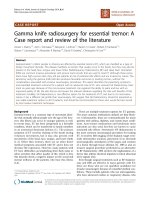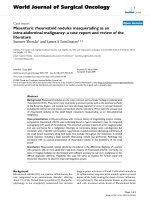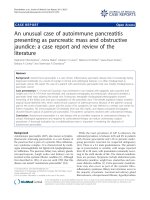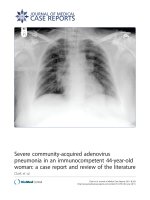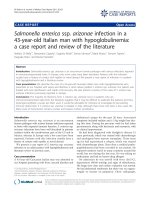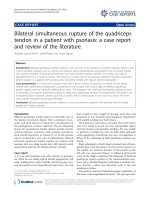Báo cáo y học: " a case report and review of the literature" ppsx
Bạn đang xem bản rút gọn của tài liệu. Xem và tải ngay bản đầy đủ của tài liệu tại đây (313.76 KB, 6 trang )
CAS E RE P O R T Open Access
Rhodococcus equi venous catheter infection:
a case report and review of the literature
Rosalinda Guerrero
1
, Ashish Bhargava
2
and Zeina Nahleh
1*
Abstract
Introduction: Rhodococcus equi is an animal pathogen that was initially isolated from horses and is being
increasingly reported as a cause of infection in humans with impaired cellular immunity. However, this pathogen is
underestimated as a challenging antagonist and is frequently considered to be a mere contaminant despite the
potential for life-threatening infections. Most case reports have occurred in immunocompromised patients who
have received organ transplants (for example kidney, heart, bone marrow) or those with human immunodeficiency
virus infection. Infections often manifest as pulmonary involvement or soft tissue abscesses. Bacteremia related to
R. equi infections of tunneled central venous catheters has rarely been described.
Case presentation: We report the case of a 63-year-old non-transplant recipient, non-HIV infected Caucasian
woman with endometrial carcinoma who developed recurrent bloodstream infections and septic shock due to R.
equi and ultimately required the removal of her port catheter, a subcutaneous implantable central venous catheter.
We also review the medical literature related to human infections with R. equi.
Conclusion: R. equi should be considered a serious pathogen, not a contaminant, particularly in an
immunocompromised patient who presents with a central venous catheter-related bloodstream infection.
Counseling patients with central venous catheters who participate in activities involving exposure to domesticated
animals is recommended.
Introduction
Rhodococcus equi is an intracellular aerobic, Gram-posi-
tive, weakly acid-fast coccobacillus. It has been recog-
nized as an animal pathogen since its original isolation
from foals with pneumonia in Sweden in 1923 [1].
Human infection with R. equi is rare but is increasingly
encountered in patients with human immunodeficiency
virus (HIV) infection [2,3], and in solid organ transplant
recipients [1,4,5]. In most of these cases, there has been
a history of contact with farm animals, contaminated
soil or manure, in which this organism is commonly
found [2]. More than 80% of cases reported in t he Eng-
lish medical literature have pulmonary involvement [5].
The remaining cases involve extrapulmonary sites such
as soft tissues, eyes and bone [5-7]. Unfortunately, this
pathogen is still underestimated as a formidable adver-
sary in vulnerable patient populations and may be
discounted by physicians and microbiology laboratories
as a contaminant [2,5].
Central venous catheter-related bacteremia due to R.
equi has been rarely described in the literature and very
few cases have been reported in cancer patients [8-10].
Many cancer patients have a special form of central
venous catheter k nown as a port. It consists of a tun-
neled s ubcutaneous reservoir with a catheter t hat con-
nects to a vein (usually the subclavian or the superior
vena cava).
We report the case of a 63-year-old woman without a
history of organ transplantation or HI V infection, diag-
nosed with recurrent endometrial carcinoma and muci-
nous carcinoma o f her appendix. During the course of
her treatment, she developed recurrent central venous
catheter port line infections and septic shock due to
R. equi, which was cultured from her central venous
catheter tip. She was ultimately successfully treated with
removal of the catheter and a combination of antibiotics.
* Correspondence:
1
Department of Internal Medicine, TTUHSC-Paul L Foster School of Medicine,
4800 Alberta Avenue, El Paso, TX 79905, USA
Full list of author information is available at the end of the article
Guerrero et al. Journal of Medical Case Reports 2011, 5:358
/>JOURNAL OF MEDICAL
CASE REPORTS
© 2011 Guerrero et al; licensee BioMed Central Ltd. This is an Open Access article distribute d under the terms of the Creative
Commons Attribution License ( which permits unrestrict ed use, distribution, and
reproduction in any medium, provided the original work is properly cited.
Case Presentation
Our patient was a 63-year-old Caucasian woman. She does
not smoke cigarettes or dr ink alcohol. She measures
162.5 cm in height and weighs 66 kilograms. She had no
significant family history. She was initially diagnosed with
stage IIIA endometrial carcinoma for which she underwent
a hysterectomy a nd bilateral salpingo opho rectomy fol-
lowed by pelvic external beam radiation therapy. Two
years later, she developed recurrent disease with wide-
spread peritoneal carcinomatosis. An incidental mucinous
carcinoma of the appendix was also found during surgical
exploration. A central venous catheter port was placed and
she received chemotherapy with 5-fluorouracil, leucovorin,
and later, irinotecan, capecitabine and oxaliplatin. Her dis-
ease progressed despite multiple lines of chemotherapy.
During the course of her cancer treatment, our patient also
developed a series of complications which included tumor-
related right ureteral obstruction requiring a nephrostomy
placement, a sigmoid-vaginal fistula necessitating a colost-
omy with reversion of the ureteral stent, small bowel
obstruction and ileostomy placement, short bowel syn-
drome and significant weight loss requiring total parenteral
nutrition. Our patient recovered gradually and was able to
receive subsequent courses of chemotherapy consisting of
capecitabine, an oral chemotherapy agent classified a s an
antimetabolite, and oxaliplatin, an intravenous platinum-
based chemotherapy agent classified as an alkylating agent.
She developed predict able chemot herapy-relat ed adverse
events including diarrhea and hand-foot syndrome, but
was able to continue her treatment intermittently. She
started developing fever and tenderness at the site of her
central venous catheter. Blood cultures were repeatedly
negative. Our patient had not received antibiotics within
the eight weeks prior to this event. She was not neutrope-
nic. Laboratory results reflected a white blood cell (WBC)
count of 12,100 cells/μL, with 87% neutrophils. Urine and
stool examination revealed no abnormal findings. Liver
and r enal function tests and a chest X-ray were normal.
Blood cultures taken from both the central venous catheter
and peripheral vein were reported to have no growth after
96 hours incubation. She received empiric vancomycin for
two weeks and all signs of infection, including fever,
resolved with normalization of WBC count to 7500 cells/
μL and 67% neutrophils. However, four weeks later, she
was admitted to the intensive care unit with a septic shock
picture; she had fever, hypotens ion and tenderness at the
site of the central venous catheter, which was then
removed. WBC count at this time was 18,400 cells/μLwith
93% neutrophils. A chest X-ray was negative for pulmon-
ary disease and sputum cultures revealed no microbial
growth. She was empirically treated with intravenous ticar-
cillin/clavulanate, ciprofloxacin and vancomycin. Cultures
from the catheter tip as well as blood cultures were
submitted for analysis. Two days later, large, irregular
mucoid colonies grew and were non-fermentative, distin-
guishing them from diphtheria colonies. Further incuba-
tion grew characteristic salmon-colored colonies of R. equi.
Microbiologic characteristics of the pathogen were as fol-
lows: catalase and urease positive; oxidase, carbohydrate
fermentation, mannitol, indole, and citric acid negative;
equi factors positive. The cultured organism was found to
be resistant in vitro to penicillins and susceptible to
erythromycin, gentamicin, tobramycin, vancomycin, imipe-
nem/cilastatin and rifampin. Our patient’s antibiotic regi-
men was modified to include the combination of a
b-lactam antibiotic (imipenem/cilastatin) and a bactericidal
antibiotic rifampin. She received imipenem 500 mg intra-
venously every 8 hrs for 14 days and rifampin 600 mg
orally daily. She was discharged on oral rifampin after reso-
lution of her symptoms and two negative blood cultures
were obtained. She continued rifampin for twenty-one
days and made a full recovery.
Discussion
The first human case with R. equi infection was
reported in 1967 in a patient with autoimmune hepatitis
who was undergoing treatment with prednisone and 6-
mercaptopurine [11]. He worked in a stockyard cleaning
animal pe ns and subsequently developed lung and sub-
cutaneous abscesses. Since then, human cases of R. equi
infection have been described in immunocompromised
patients. In this subpopulation o f patients, such infec-
tions portend high mortality rates and usually require
prolonged treatment with multiple antibiotics [2-8,12].
In contrast, immunocompetent patients respond well to
shorter courses of antibiotics, usually with a single agent
[13,14]. With the exception of Antarctica, R. equi has
been identified in soils all over the world, in fresh and
sea water and in animals including horses, cattle and
wild birds [5]. Human infection can be acquired through
inhalation from the soil, inoculation into a wound or
ingestion and passage through the alimentary tract [4,5].
Other routes o f acquisition include nosocomial spread,
human colonization and person-to-person t ransmission
[15]. Exposure to domesticated animals such as horses
and pigs has been reported in some cases of infection
[16]. Our patient may have potentially acquired R. equi
via exposure to contaminated horse fibers that she uses
for her sculptures.
In immunocompromised patients, pulmonary involve-
ment is common, with necrotizing pneumonia being the
most frequent presentation [4]. Infection with this
organism can be life-threat ening and the required t reat-
ment is often lengthy. In imm unocompetent patients,
pulmonary infections are also common and account for
42% of reported cases [14]. Pulmonary infections have a
Guerrero et al. Journal of Medical Case Reports 2011, 5:358
/>Page 2 of 6
relapsing and remitting course with intermittent bacter-
emia. The onset of symptoms is usually insidious and
may occur over a span of days to weeks, with the
patient presenting with fever, non-productive cough,
dyspnea and pleuritic chest pain. In some cases, weight
loss and hemoptysis, severe enough as to require b lood
transfusions, have also been noted. Chest radiographs
typical ly reveal pulmonary infiltrates with single or mul-
tiple lung segments, mainly in the upper lobes. The
radiographic changes bear a striking resemblance to
those changes that occur with fungal or tubercular
infections. Cavitations, pleural effusions or empyema
evolve over a two to four week period [4]. Primary
extrapulmonary manifestations are unusual and occur
for the most part secondary to hematogenous dissemi-
nation. Examples include subcutaneous nodules, brain
and renal abscess, lymphadenitis, endophthalmitis and
osteomyelitis [17].
Blood cultures are positive in more than one-half of
immunocompromised patients with R. equi infection com-
pared to only 10% of normal hosts [18]. Cultures of
R. equi grow easily under aerobic conditions on non-selec-
tive media. Large, irregular, highly mucoid colonies usually
grow optimally at 30°C and t urn to a salmon-pink color
within 48 hours [18]. Further incubation leads to release
of its red pigment leading to its characteristic salmon-
colored colonies. It is non-fermentive which differentiates
Rhodococcus from Coryne bacterium. R. equi is catalase-
and urease-positive, and oxidase-negative. Biochemical
kits are now available which facilitate identification of
R. equi. Our patient had recurrent infections of the central
venous catheter which eventually led to its removal. The
first set of blood cultures was reported as negative. This
may have occurred, in part, due to the fact that infections
with R. equi are missed because of incomplete or improper
identification of the organism [4,5]. In addition, the
appearance of R. equi as a Gram-positive, weakly acid-fast,
diphtheroid-like organism may lead to mistaken identity
with a component of the normal flora or a contaminant (a
diphtheroid, a micrococcus, or a Bacillus species) [2].
Therefore, a high degree of suspicion should be exercised
in susceptible patients. Once R. equi is cultured from a
sterile site, it should never be considered a contaminating
diphtheroid. Septic shock in our patient resulted in part
from recurrent infections of the central venous catheter.
Infections with R. equi may be life-threatening due to
the toxicity of this organism, which is mediated by the pre-
sence of large plasmids that encode proteins necessary for
virulence inside the cell [19]. This coding process ensures
the pathogen’s ability to persist and destroy macrophages
in the immunocompromised patient [20,21]. Infection of
macrophages with R. equi results in cytotoxicity, particu-
larly in high bacterial loads [22], and is regulated by viru-
lence-associated plasmids (VAP) [22,23]. More recent
work suggests that the type of plasmid that is overcome by
aspecificR. equi strain determines its host specificity, as
described by the plasmid-typing scheme known as TRA-
VAP [23]. TRAVAP is an acronym that represents a poly-
merase chain reaction (PCR) typing system for R. equi in
which three plasmid gene markers are evaluated. The first
marker is the traA which is found in the conserved conju-
gal transfer machinery while vapA and vapB are found in
two different plasmid subpopulations [23]. In humans and
in healthy or afflicted animals with tuberculous-appearing
lesions, isolated strains of R. equi often possess a VAP cod-
ing for a surface-localized 20-kDa protein, and has been
referred to as “ vapB” due to its high homolog y to the
vapA protein [19,24]. VapA and vapB sequences are
strongly related to each other (83.6% identity) [24] and so
are the plasmids encoding them [25]. Possession of certain
vaps seems to be specific for strains infecting foals, pigs or
cattle [19], but it is likely that R. equi infections of humans
are not determined by particular plasmids but by the basal
and chromosomally determined pathogenic potential of R.
equi [26]. Chromosomally encoded factors involved in R.
equi virulence h ave been reported [26,27] The mortality
rate for R. equi infection among immunocompetent
patients is approximately 10%, compared with rates of 20-
55% among immunocompromised patients, in particular,
those with HIV [7]. In humans, R. equi typically resides in,
and destroys, macrophages, making it difficult to eradicate
especially in immunocompromisedpatients[12].Thisis
exemplified in our case. The organism persisted and colo-
nized the central venous catheter after vancomycin ther-
apy, despite therapeutic trough levels, with the organism
remaining susceptible to vancomycin. Another factor that
may have led to therapeutic failure is the fact that this
organism can inhibit macrophage phagosome-lysosome
fusion and survives within the cell. Therefore, vancomycin
monotherapy may not be the ideal approach to the man-
agement of central venous catheter bacteremia with R.
equi, despite its susceptibility to vancomycin. Combination
antimicrobial therapy using bactericidal and intracellular-
active agents should be considered. Also, prompt removal
of the infected central venous catheter is necessary for
adequate infection control, as was the case in our patient.
Therapeutic failure may also occur following a deficient
course of treatment. Based on similar experiences with dif-
ficult-to-treat organisms like Mycobacterium tuberculosis
,
an
d on the fact that distant relapses of rhodococcus infec-
tion are common, prolonged therapy is recommended
[28]. Although there is no consensus on the optimal dura-
tion or regimen of antibiotic treatment, the use of combi-
nation therapy may decrease the risk of developing
resistan ce during therapy, which has been described with
penicillin and other b-lactam antibiotics. A carbapenem
and a glycopeptide, such as meropenem and vancomycin,
are good choices [29]. The combination of macrolides and
Guerrero et al. Journal of Medical Case Reports 2011, 5:358
/>Page 3 of 6
rifampin can also be considered [30]. Other combinations
may include a macrolide antibiotic such as erythromycin
along with rifampin, vancomycin, fluoroquinolones, ami-
noglycosides or broad spectrum b-lactam antibiotics such
as imipenem/cilastatin [28-32]. After initial improvement,
the patient can be treated with an oral regimen that could
include combinations of quinolones, tetracycline, macro-
lides, and rifampin.
The optimal duration of treatment is unknown. Our
patient was successfully treated with a combination of
imipenem/cilastatin and rifampin for 14 days, and then
continued o ral rifampin for 21 days. Due to the intracel-
lular nature of the pathogen, which concentrates in gran-
ulocytes and macrophages [31], a prolonged treatment
course is advised in immunocompromised patients due
to frequent relapses following abbreviated treatment
courses. Monotherapy with penicillin and most other
b-lactam antibiotics should be avoided even if R. equi is
initially sensitive, since b-lactam resistance may develop
during therapy [2]. Also, the minimal inhibitory concen-
trations of rifampin and erythromycin for R. equi strains
isolated within the last 10 years have been rising [33] and
the emergence of resistant strains to different antibiotics
have been reported [34]. These findings highlight the
need for strategies other than antibiotic therapy to pre-
vent or treat R. equi infections, such as applications of
gallium nitrate and vaccination methods [35-41]. In the
case of patients taking immunosuppressive therapy fol-
lowing organ transplants, the challenge in the treatment
of R. equi is the possible interactions of common combi-
nation therapy like macrolide antibiotic and rifampin
with immunosup pressive agents l ike tacrolimus or
cyclosporine, which are routinely used in the se patients.
In one case report of a heart transplant patient on immu-
nosuppressive therapy, the excellent response to treat-
ment of R. equi occurred following the treatment with a
combination of minocycline and a fluoroquinolone [42].
Overall there is no agreement on the treatment of R. equi
infections in transplant recipients receiving immunosup-
pressive therapy. A review of the literature and scattered
case reports describes different combinations that may
prove beneficial in organ transplant recipients, such as a
case of a kidney transplant patient who had good results
using the combination of carbapenem and teicoplanin
[43]. Synergistic combinations of medications are also
key, as was demonstrated in human isolates determined
by fractional inhibitory concentration indices. Such
combinations included: rifampin-minocycline, erythro-
mycin-minocycline, rifampin-erythromycin and imipe-
nem-amikacin [44]. Weinstock and Brown [45] proposed
an algorithm for the management of R. equi infections in
immunocompromised hosts. T hey recommended an
initial treatment with two agents to avoid development of
resistance. Vancomycin, carbapenems, quinolones,
erythromycin, and ri fampin are reasonable first cho ices.
Careful scrutiny of all other medications is mandatory if
drug interactions are to be avoided. Later adjustment of
therapy based on susceptibility data is recommended.
After two weeks of intravenous therapy and attendant
clinical improvement, oral antibiotics may be substituted
with rifampin, erythromycin, or ciprofloxacin [45]. Six
months or more of therapy may be required for lung,
bone and joint, and cerebral infections [45]. Novel diag-
nostic techniques using specific quantitative PCR should
be further explored [46,47].
Conclusion
Human infection with R. equi should be considered
when evaluating immunocompromised patients with a
central venous catheter and fever in the setting of expo-
sure to farm animals. Microbiologi sts should be familiar
with the growth requirements and biochemical proper-
ties of this organism. If the pathogen is suspected and
identified, the tunneled central venous catheter should
be removed to prevent recurrence. Due to the fact that
virulent strains of R. equi are resistant to phagocytosis
and intracellular killing by macrophages, pati ents shou ld
receive a combination of bactericidal and intracellular-
active agents that will penetrate cells, such as rifampin
and macrolide antibiotics. A prolonged course of an oral
antibiotic follo wing initial intravenous therapy has been
suggested in the light of frequent relapses with shorter
courses. Counseling should be provided to immunocom-
promised patients inclined to participate in activities
involving exposure to domesticated animals or their
products.
Consent
Written informed consent was obtained from the patient
for publication of this case report. A copy of the written
consent is available for review by the Editor-in-Chief of
this journal.
Author details
1
Department of Internal Medicine, TTUHSC-Paul L Foster School of Medicine,
4800 Alberta Avenue, El Paso, TX 79905, USA.
2
Department of Internal
Medicine, Wayne State University/Detroit Medical Center, 4100 John R,
4HWCRC, Detroit, MI 48201, USA.
Authors’ contributions
ZN developed the manuscript idea, gathered case details, performed the
history, physical exam and the treatment of the patient, and co-wrote and
edited the manuscript. RG was a major contributor in writing the
manuscript. AB reviewed the literature and contributed to writing the
manuscript. All authors read and approved the final manuscript.
Competing interests
The authors declare that they have no competing interests.
Received: 3 December 2009 Accepted: 9 August 2011
Published: 9 August 2011
Guerrero et al. Journal of Medical Case Reports 2011, 5:358
/>Page 4 of 6
References
1. Magnusson H: Spezifische infektiose pneumonie beim fohlen: ein neuer
eitererreger beim pferd. Arch Wiss Prakt Tierheilkd 1923, 50:22-38.
2. Topino S, Galati V, Grilli E, Petrosillo N: Rhodococcus equi infection in HIV-
infected individuals: case reports and review of the literature. AIDS
Patient Care STDS 2010, 24(4):211-222.
3. Vladusic I, Krajinovic V, Begovac J: [Long term survival after Rhodococcus
equi pneumonia in a patient with human immunodeficiency virus
infection in the era of highly active antiretroviral therapy: case report
and review.]. Acta Med Croatica 2006, 60(3):259-263.
4. Perez MGV, Vassilev T, Kemmerly SA: Rhodococcus equi infection in
transplant recipients: a case of mistaken identity and review of the
literature. Transpl Infect Dis 2002, 4(1):52-56.
5. Weinstock DM, Brown AE: Rhodococcus equi: an emerging pathogen. Clin
Infect Dis 2002, 34(10):1379-1385.
6. Kamboj M, Kalra A, Kak V: Rhodococcus equi brain abscess in a patient
without HIV. J Clin Pathol 2005, 58(4):423-425.
7. Napoleao F, Damasco PV, Camello TC, do Vale MD, de Andrade AF, Hirata R
Jr, de Mattos-Guaraldi AL: Pyogenic liver abscess due to Rhodococcus equi
in an immunocompetent host. J Clin Microbiol 2005, 43(2):1002-1004.
8. Cid A, Jarque I, Salavert M, Martin G, Perez-Belles C, Sanz MA: Recurrent
bacteremia caused by Rhodococcus equi in a non-neutropenic patient
with acute myeloid leukemia in complete remission. Haematologica 2002,
87(1):ECR03.
9. Hsueh PR, Hung CC, Teng LJ, YU MC, Chen YC, Wang HK, Luh KT: Report of
invasive Rhodococcus equi infections in Taiwan, with an emphasis on the
emergence of multidrug-resistant strains. Clinical Infect Dis 1998,
27(2):370-375.
10. Sladeck GG, Frame JN: Rhodococcus equi causing bacteremia in an adult
with acute leukemia. South Med J 1993, 86(2):244-246.
11. Golub B, Falk G, Spink WW: Lung abscess due to Corynebacterium equi.
Report of first human infection. Ann Intern Med 1967, 66(6):1174-1177.
12. Arya B, Hussian S, Hariharan S: Rhodococcus equi pneumonia in a renal
transplant patient: a case report and review of literature.
Clin Transplant
2004, 18(6):748-752.
13.
Ulivieri S, Oliveri G: Cerebellar abscess due to Rhodococcus equi in an
immunocompetent patient. Case report and literature review. J
Neurosurg Sci 2006, 50(4):127-129.
14. Kedlaya I, Ing MB, Wong SS: Rhodococcus equi infections in
immunocompetent hosts. Case report and review. Clin infect Dis 2001,
32(3):E39-46.
15. Scotton PG, Tonon E, Globbia M, Galluci M, Rigoli R, Vaglia A: Rhodococcus
equi nosocomial meningitis cured by levofloxacin and shunt removal.
Clin Infect Dis 2000, 3(1):240-242.
16. Gray KJ, French N, Lugada E, Watera C, Gilks CF: Rhodococcus equi and
HIV1 infection in Uganda. J Infect 2000, 41(3):227-231.
17. Nasser AA, Bizri AR: Chronic scalp wound infection due to Rhodococcus
equi in an immunocompetent patient. J Infect 2001, 42(1):67-78.
18. Verville TD, Huycke MM, Greenfield RA: Rhodococcus equi in humans: 12
cases and a review of the literature. Medicine (Baltimore) 1994,
73(3):119-132.
19. Byrne BA, Prescott JF, Palmer GH, Takai S, Nicholson VM, Alperin DC,
Hines SA: Virulence plasmid of Rhodococcus equi contains inducible gene
family encoding secreted proteins. Infect Immun 2001, 69(2):650-656.
20. Luhrmann A, Mauder N, Sydor T, Fernandez-Mora E, Schulze-Luehrmann J,
Takai S, Haas A: Necrotic death of Rhodococcus equi-infected
macrophages is regulated by virulence-associated plasmids. Infect Immun
2004, 72(2):853-862.
21. Prescott JF: Rhodococcus equi: an animal and human pathogen. Clin
Microbial Rev 1991, 4(1):20-34.
22. Takai S, Son WG, Lee DS: Rhodococcus equi virulence plasmids recovered
from horses and their environment in Jeju, Korea: 90-kb type II and a
new variant, 90-kb type V. J Vet Med Sci 2003, 65(12):1313-1317.
23. Ocampo-Sosa AA, Lewis DA, Navas J, Quigley F, Callejo R, Scortti M,
Leadon DP, Fogarty U, Vazquez-Boland JA: Molecular epidemiology of
Rhodococcus equi based on traA, vapA and vapB virulence plasmid
markers. J Infect Dis 2007, 196(5):763-769.
24. Letek M, Ocampo-Sosa AA, Sanders M, Fogarty U, Buckley T, Leadon DP,
González
P, Scortti M, Meijer WG, Parkhill J, Bentley S, Vázquez-Boland JA:
Evolution of Rhodococcus equi vap pathogenicity island seen through
comparison of host-associated vapA and vapB virulence plasmids.
J Bacteriol 2008, 190(17):5797-5805.
25. Von Bargen K, Haas A: Molecular and infectious biology of the horse
pathogen Rhodococcus equi. FEMS Microbiol Rev 2009, 33(5):870-891.
26. Rahman MT, Herron LL, Kapur V: Partial genome sequencing of
Rhodococcus equi ATCC 33701. Vet Microbiol 2003, 94(2):43-158.
27. Giguere S, Prescott JF: Clinical manifestations, diagnosis, treatment, and
prevention of Rhodococcus equi infections in foals. Vet Microbiol 2006,
56(3-4):313-334.
28. Heidmann P, Madigan J, Watson J: Rhodococcus equi pneumonia: clinical
findings, diagnosis, treatment and prevention. Clin Tech Equine Pract
2006, 5(3):203-210.
29. Tse KC, Tang SC, Chan TM, Lan KN: Rhodococcus lung abscess
complicating kidney transplantation: successful management by
combination antibiotic therapy. Transpl Infect Dis 2008, 10(1):44-47.
30. Prescott JF: Rhodococcus equi: an animal and human pathogen. Clin
Microbiol Rev 1991, 4(1):20-34.
31. Buckley T, McManamon E, Stanbridge S: Resistance studies of
erythromycin and rifampin for Rhodococcus equi over a 10-year period.
Irish Vet J 2007, 60(12):728-731.
32. Hurley JR, Begg AP: Failure of hyperimmune plasma to prevent
pneumonia caused by Rhodococcus equi in foals. Aust Vet J 1995,
72(11):418-420.
33. Niwa H, Hobo S, Anzai T: A nucleotide mutation associated with
fluoroquinolone resistance observed in gyrA of in vitro obtained
Rhodococcus equi mutants. Vet Microbiol 2006, 115(1-3):264-268.
34. Harrington JR, Martens RJ, Cohen ND, Bernstein LR: Antimicrobial activity
of gallium against virulent Rhodococcus equi in vitro and in vivo. J Vet
Pharmacol Ther 2006, 29(2):121-127.
35. Hooper-McGrevy KE, Wilkie BN, Prescott JF: Virulence-associated protein-
specific serum immunoglobulin G-isotype expression in young foals
protected against
Rhodococcus equi pneumonia
by oral immunization
with virulent R. equi. Vaccine 2005, 23(50):5760-5767.
36. Hurley JR, Begg AP: Failure of hyperimmune plasma to prevent
pneumonia caused by Rhodococcus equi in foals. Aust Vet J 1995,
72(11):418-420.
37. Lopez AM, Townsend HG, Allen AL, Hondalus MK: Safety and
immunogenicity of a live-attenuated auxotrophic candidate vaccine
against the intracellular pathogen Rhodococcus equi. Vaccine 2008,
26(7):998-1009.
38. Machang RS, Prescott JF: Role of anibody to extracellular proteins of
Rhodococcus equi in protection against R. equi pneumonia in foals. Vet
Microbio 1991, 26(4):323-333.
39. Oliveira AF, Ferraz LC, Brocchi M, Roque-Barreira MC: Oral administration of
a live attenuated Salmonella vaccine strain expressing the VapA protein
induces protection against infection by Rhodococcus equi. Microbes Infect
2007, 9(3):382-390.
40. Pei Y, Nicholson V, Woods K, Prescott JF: Immunization by intrabronchial
administration to 1-week-old foals of an unmarked double gene
disruption strain of Rhodococcus equi strain 103+. Vet Microbiol 2007,
125(1-2):100-110.
41. Prescott JF, Nicholson VM, Patterson MC, Zandona Meleiro MC, Caerino de
Araujo A, Yager JA, Holmes MA: Use of Rhodococcus equi virulence-
associated protein for immunization of foals against R. equi pneumonia.
Am J Vet Res 1997, 58(4):356-359.
42. Kwak EJ, Strollo DC, Kulich SM, Kusne R: Cavitary pneumonia due to
Rhodococcus equi in a heart transplant recipient. Transpl Infect Dis 2003,
5(1):43-46.
43. El Karoui K, Guillet C, Sekkal N, Lanternier F, Méchaï F, Hue K, Hiesse C,
Mamzer Bruneel MF, Catherinot E, Viard JP, Mainardi JL, Lecuit M, Ferroni A,
Lortholary O: Synergistic effect of carbapenem-teicoplanin combination
during severe Rhodococcus equi pneumonia in a kidney transplant
recipient. Transpl Infect Dis 2009, 11(4):359-362.
44. Nordmann P, Ronco E: In-vitro antimicrobial susceptibility of Rhodococcus
equi. J Antimicrob Chemother 1992, 29(4):383-393.
45. Weinstock DM, Brown AE: Rhodococcus equi: an emerging pathogen. Clin
Infect Dis 2002, 34(10):1379-1385.
46.
Ladron N, Fernandez M, Aguero J, Gonzalez Zorn B, Vazquez-Boland JA,
Navas J: Rapid identification of Rhodococcus equi by a PCR assay
targeting the choE gene. J Clin Microbiol 2003, 41(7):3241-3245.
Guerrero et al. Journal of Medical Case Reports 2011, 5:358
/>Page 5 of 6
47. Rodríguez-Lázaro D, Lewis DA, Ocampo-Sosa AA, Fogarty U, Makrai L,
Navas J, Scortti M, Hernández M, Vázquez-Boland JA: Internally controlled
real-time PCR method for quantitative species-specific detection and
vapA genotyping of Rhodococcus equi. Appl Environ Microbiol 2006,
72(6):4256-4263.
doi:10.1186/1752-1947-5-358
Cite this article as: Guerrero et al.: Rhodococcus equi venous catheter
infection: a case report and review of the literature. Journal of Medical
Case Reports 2011 5:358.
Submit your next manuscript to BioMed Central
and take full advantage of:
• Convenient online submission
• Thorough peer review
• No space constraints or color figure charges
• Immediate publication on acceptance
• Inclusion in PubMed, CAS, Scopus and Google Scholar
• Research which is freely available for redistribution
Submit your manuscript at
www.biomedcentral.com/submit
Guerrero et al. Journal of Medical Case Reports 2011, 5:358
/>Page 6 of 6
